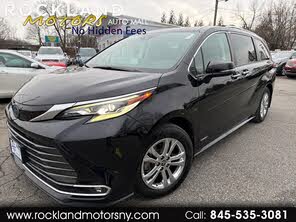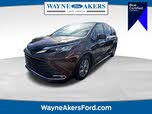2021 Toyota Sienna vs 2020 Mercedes-Benz GLE
Overview | |
MSRP$53,700 | MSRP$34,460 |
Listings859 | Listings627 |
Ratings & Reviews | |
User Reviews | User Reviews |
Expert reviews6.8 out of 10 | Expert reviews8.3 out of 10 |
Pros
Cons
| Pros
Cons
|
2020 Mercedes-Benz GLE Reviews SummaryMercedes-Benz refers to the 2020 GLE-Class as a “second-generation model.” But savvy students of car culture will remember that the GLE-Class is actually a renamed M-Class, meaning this is actually a fourth-generation model that’s been in production since 1997. It has a legacy to uphold, and because of that, it’s just as quiet and comfortable as you’d expect. A longer wheelbase means more room inside, and the new MBUX infotainment system may be the best on the market. But this doesn’t mean the GLE-Class is walking away with all the laurels. Sharing a segment with the BMW X5—itself redesigned for 2019—means the GLE-Class is up against some tough competition. And with the usual luxury pricing structure in place, things can get expensive very easily. | |
2021 Toyota Sienna Reviews SummaryToyota’s minivan got a major makeover for 2021, now entering its fourth generation of production since debuting as a 1997 model. For the first time, the Sienna gets a hybrid gasoline-electric powertrain, and not only that—it’s standard equipment. The Sienna Hybrid is built on the Toyota New Global Architecture (TNGA-K) platform, shared with the Highlander and other current Toyota models. | |
No video found | |
Popular Features & Specs | |
Engine2.0L 255 hp I4 | Engine2.5L 245 hp I4 Hybrid |
Drive TrainRWD | Drive TrainFWD |
Seating Capacity7 | Seating Capacity8 |
Horsepower255 hp @ 5800 rpm | Horsepower |
EV Battery Capacity | EV Battery Capacity1.9 kWh |
MPG City20 | MPG City36 |
MPG Highway27 | MPG Highway36 |
Engine | |
Engine Name2.0L 255 hp I4 | Engine Name2.5L 245 hp I4 Hybrid |
Torque273 lb-ft @ 1800 rpm | Torque |
Horsepower255 hp @ 5800 rpm | Horsepower |
DrivetrainRWD | DrivetrainFWD |
Fuel Economy | |
EV Battery Capacity | EV Battery Capacity1.9 kWh |
MPG City20 | MPG City36 |
MPG Highway27 | MPG Highway36 |
Interior | |
Seating Capacity7 | Seating Capacity8 |
Key Features | |
Navigation SystemStandard | Navigation System |
Sunroof/MoonroofStandard | Sunroof/Moonroof |
Safety | |
Front Crash Overall | Front Crash Overall4 |
Side Crash Overall | Side Crash Overall5 |
Dimensions & Capacity | |
Cargo Space33.3 cu ft | Cargo Space33.5 cu ft |
Curb Weight4608 lbs | Curb Weight4610 lbs |
Height70.7 in | Height68.5 in |
Length194.3 in | Length203.7 in |
Width84.9 in | Width78.5 in |
Wheelbase117.9 in | Wheelbase120.5 in |
Maximum Payload | Maximum Payload1560 lbs |
Number of doors4 | Number of doors4 |
Maximum Towing Capacity5950 lbs | Maximum Towing Capacity3500 lbs |
Overview | ||
MSRP | $53,700 | $34,460 |
Listings | ||
Ratings & Reviews | ||
User reviews | ||
Expert reviews | 6.8 out of 10Read full review | 8.3 out of 10Read full review |
Pros & cons | Pros
Cons
| Pros
Cons
|
Summary | Mercedes-Benz refers to the 2020 GLE-Class as a “second-generation model.” But savvy students of car culture will remember that the GLE-Class is actually a renamed M-Class, meaning this is actually a fourth-generation model that’s been in production since 1997. It has a legacy to uphold, and because of that, it’s just as quiet and comfortable as you’d expect. A longer wheelbase means more room inside, and the new MBUX infotainment system may be the best on the market. But this doesn’t mean the GLE-Class is walking away with all the laurels. Sharing a segment with the BMW X5—itself redesigned for 2019—means the GLE-Class is up against some tough competition. And with the usual luxury pricing structure in place, things can get expensive very easily. | Toyota’s minivan got a major makeover for 2021, now entering its fourth generation of production since debuting as a 1997 model. For the first time, the Sienna gets a hybrid gasoline-electric powertrain, and not only that—it’s standard equipment. The Sienna Hybrid is built on the Toyota New Global Architecture (TNGA-K) platform, shared with the Highlander and other current Toyota models. |
Video | No video found | |
Popular Features & Specs | ||
Engine | 2.0L 255 hp I4 | 2.5L 245 hp I4 Hybrid |
Drive Train | RWD | FWD |
Seating Capacity | 7 | 8 |
Horsepower | 255 hp @ 5800 rpm | |
EV Battery Capacity | 1.9 kWh | |
MPG City | 20 | 36 |
MPG Highway | 27 | 36 |
Engine | ||
Engine Name | 2.0L 255 hp I4 | 2.5L 245 hp I4 Hybrid |
Torque | 273 lb-ft @ 1800 rpm | |
Horsepower | 255 hp @ 5800 rpm | |
Drivetrain | RWD | FWD |
Fuel Economy | ||
EV Battery Capacity | 1.9 kWh | |
MPG City | 20 | 36 |
MPG Highway | 27 | 36 |
Interior | ||
Seating Capacity | 7 | 8 |
Key Features | ||
Navigation System | Standard | |
Sunroof/Moonroof | Standard | |
Safety | ||
Front Crash Overall | 4 | |
Side Crash Overall | 5 | |
Dimensions & Capacity | ||
Cargo Space | 33.3 cu ft | 33.5 cu ft |
Curb Weight | 4608 lbs | 4610 lbs |
Height | 70.7 in | 68.5 in |
Length | 194.3 in | 203.7 in |
Width | 84.9 in | 78.5 in |
Wheelbase | 117.9 in | 120.5 in |
Maximum Payload | 1560 lbs | |
Number of doors | 4 | 4 |
Maximum Towing Capacity | 5950 lbs | 3500 lbs |
Comparing the aesthetics and ambiance of these two vehicles, the 2020 Mercedes-Benz GLE-Class showcased a softer, more refined exterior compared to its predecessor. Mercedes designers rounded out all lines, dropping the drag coefficient from .32 to .29, a notable achievement that bolstered its class-leading status. Most dramatic were the changes to the front end, enhancing its handsomely understated look. However, a drawback noted was the surprising orange-peel effect observed on the $720 Emerald Green Metallic paint, an imperfection unexpected in a car of this caliber.
Inside, the GLE-Class offered an elevated experience with an increase in headroom and an extension of the wheelbase by 3.1 inches, which translated to more legroom and the potential for an optional third row—though this remained unverified by the tester. The tester car’s lush interior boasted black leather upholstery, an array of luxurious add-ons like multi-contour front seats with a massage feature, a $500 fragrance system that wasn’t particularly favored, and heated and ventilated seats requiring additional expenses. Notably, the car's sophisticated yet extensive options list could rapidly swell its price tag.
Conversely, the 2021 Toyota Sienna sought to overturn the typical minivan perception, leaning towards an SUV-like appearance. A wide grille and horizontally arranged LED headlamps imparted a sleek, commanding presence, while sculpted sliding doors and substantial alloy wheels (ranging from 17 to 20 inches based on trims) reinforced its assertive stance. Interior-wise, the Sienna emphasized width with uncluttered horizontal lines and a clever center console featuring a bridge design for added storage convenience—a very thoughtful touch.
The Sienna's functional interior followed suit, providing ample comfort and convenience across its three rows. The captain’s chairs in the seven-passenger model and the eight-passenger bench seat versions were notably accommodating with the second row's significant fore and aft sliding capability. Fit and finish inside the Sienna were nothing short of Toyota's reputed quality standard.











Powering the 2020 Mercedes-Benz GLE 350 was a turbocharged 2.0-liter 4-cylinder engine, delivering 255 horsepower and 273 pound-feet of torque. While sufficient at high speeds, the engine felt sluggish from a stop due to noticeable turbo lag, an issue compounded by the vehicle’s near 5,000-pound weight. Additionally, the start-stop system on this model was the least smooth tested thus far. Fuel economy for the AWD GLE 350 was commendable, achieving 19 mpg city, 26 highway, and 22 combined, though the BMW X5, a close competitor, managed better urban mileage with its standard inline-6 engine.
Switching to the 2021 Toyota Sienna, we observed Toyota’s debut hybrid minivan featuring a 2.5-liter four-cylinder engine coupled with two electric motors, producing a combined 243 horsepower. Both FWD and AWD were options, with the latter utilizing a separate electric motor to drive rear wheels, thus simplifying mechanical complexity. The Sienna employed an electronically controlled CVT, known for its fuel efficiency but less thrilling throttle response. Four selectable drive modes allowed for some customization, though the performance felt muted compared to more conventional powertrains. Nonetheless, the Sienna significantly upped its game in handling, sporting a new TNGA front suspension and an independent rear suspension, which together delivered impressive ride comfort and minimal body roll. Furthermore, its fuel economy was startlingly good, with FWD models achieving 36 mpg in all driving conditions, slightly lower for AWD at 35 mpg combined.
The interior of the 2020 Mercedes-Benz GLE-Class was made more spacious thanks to the extended wheelbase, offering between 33.3 to 39.3 cubic feet of cargo space behind the second row and up to 79.4 cubic feet with those seats folded down. The cabin featured significant technological advancements, including dual 12.3-inch screens and a HUD, although these could feel overwhelming and sometimes obstructed by the steering wheel. Seats, while generally comfortable, had a slightly tricky lumbar support adjustment. The upgraded Burmester stereo and Acoustic Package combined well, although vexing pedal vibration persisted with the bass turned down.
In comparison, the 2021 Toyota Sienna excelled in maximizing space for practical use. It housed a well-thought-out interior with 16 cupholders, storage cubbies in every row, and a third-row seat that stowed easily into the floor. Flexibility was underscored by the second row's ability to slide 25 inches, facilitating entry to the third row. Cargo capacity measured 33.5 cubic feet behind the third row, 75.2 behind the second row, and expanded to a whopping 101.0 cubic feet with the first row taken into account, even accommodating a full sheet of plywood with the tailgate closed. The Sienna also ingeniously hid its 288-volt Ni-MH battery pack under the front seats, ensuring no loss in cargo space.
Technologically, the 2020 Mercedes-Benz GLE-Class was equipped with the advanced MBUX infotainment system, a sophisticated and initially daunting platform. Twin 12.3-inch screens and a HUD provided comprehensive information, augmented by features such as augmented reality for navigation. While the new voice control system showed promise, it was less reliable in the GLE than in previous models. The overall suite of driver-assistance tech, although advanced, exhibited inconsistencies, especially at higher speeds.
Technology in the 2021 Toyota Sienna was abundant and practical. Across all trims, a standard nine-inch touchscreen interface supported Apple CarPlay, Android Auto, Amazon Alexa, and SiriusXM. The Sienna also offered a year’s trial of Safety Connect and Remote Connect, ten years of Service Connect, and a three-month AT&T WiFi Connect trial. Higher trims featured Qi-compatible wireless charging, a Premium Audio + JBL package with a 12-speaker setup, and an available rear-seat entertainment setup with an 11.6-inch display. A digital rearview mirror and a head-up display (HUD)—a first in its class—were exclusive to the Platinum trim, significantly enhancing driver convenience.
Safety features for the 2020 Mercedes-Benz GLE-Class incorporated a broad suite of autonomous systems, including Attention Assist to prevent drowsiness and Seat Kinetics to alleviate long-drive discomfort. The driver-assistance package, although comprehensive, struggled at high speeds, making it frustrating to use due to erratic lane-keeping behavior and false readings from road shadows.
On the 2021 Toyota Sienna, Toyota Safety Sense 2.0 was standard, encompassing dynamic radar cruise control, lane-tracing assist, pre-collision with pedestrian detection, lane-departure alert, automatic high beams, and road sign assist. The Sienna featured 10 airbags, LATCH connectors, and a thoughtful rear-seat reminder system. A tire pressure monitoring system with an inflator kit came standard—buyers could opt for a spare tire as well. Though IIHS and NHTSA ratings were pending, the previous model year’s solid ratings indicated a strong safety record.
CarGurus highlights

According to CarGurus experts, the overall rating for the 2020 Mercedes-Benz GLE-Class was 6.8 out of 10, while the 2021 Toyota Sienna scored 8.3 out of 10. Based on these ratings, the 2021 Toyota Sienna would be the more highly recommended choice. Its combination of hybrid efficiency, family-friendly features, and advanced technology makes it a standout in the minivan category, ideal for buyers seeking practicality and excellent value for their money.
Choose the 2021 Toyota Sienna if:
- Fuel economy and the practicality of a hybrid powertrain are significant to you.
- You need a versatile, spacious interior with excellent cargo capacity and family-friendly features.
- Safety and room for modern technological conveniences are top priorities.
Choose the 2020 Mercedes-Benz GLE if:
- You prioritize luxurious interiors and advanced technological features.
- Higher performance and the prestige of owning a luxury brand are crucial.
- You value customizable options and are willing to invest in premium add-ons.
CarGurus highlights

According to CarGurus experts, the overall rating for the 2020 Mercedes-Benz GLE-Class was 6.8 out of 10, while the 2021 Toyota Sienna scored 8.3 out of 10. Based on these ratings, the 2021 Toyota Sienna would be the more highly recommended choice. Its combination of hybrid efficiency, family-friendly features, and advanced technology makes it a standout in the minivan category, ideal for buyers seeking practicality and excellent value for their money.
Choose the 2021 Toyota Sienna if:
Shop Now- Fuel economy and the practicality of a hybrid powertrain are significant to you.
- You need a versatile, spacious interior with excellent cargo capacity and family-friendly features.
- Safety and room for modern technological conveniences are top priorities.
Choose the 2020 Mercedes-Benz GLE if:
Shop Now- You prioritize luxurious interiors and advanced technological features.
- Higher performance and the prestige of owning a luxury brand are crucial.
- You value customizable options and are willing to invest in premium add-ons.

By: CarGurus + AI
At CarGurus, our team of experienced automotive writers remain at the heart of our content operation, conducting hands-on car tests and writing insightful guides that are backed by years of industry experience. To complement this, we are harnessing AI to make our content offering more diverse and more helpful to shoppers than ever. To achieve this, our AI systems are based exclusively on CarGurus content, ratings and data, so that what we produce is both unique to CarGurus, and uniquely helpful to car shoppers.







































